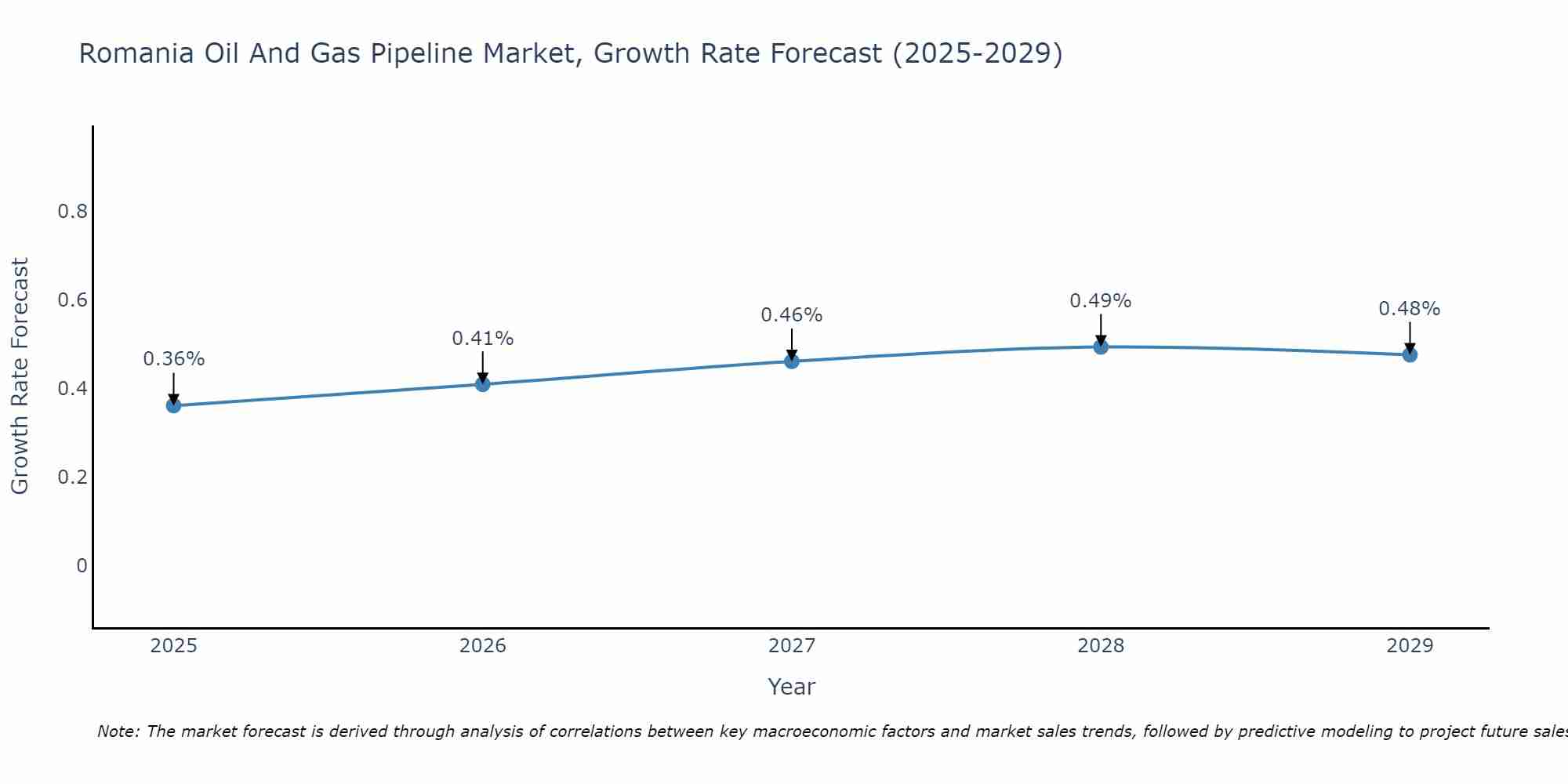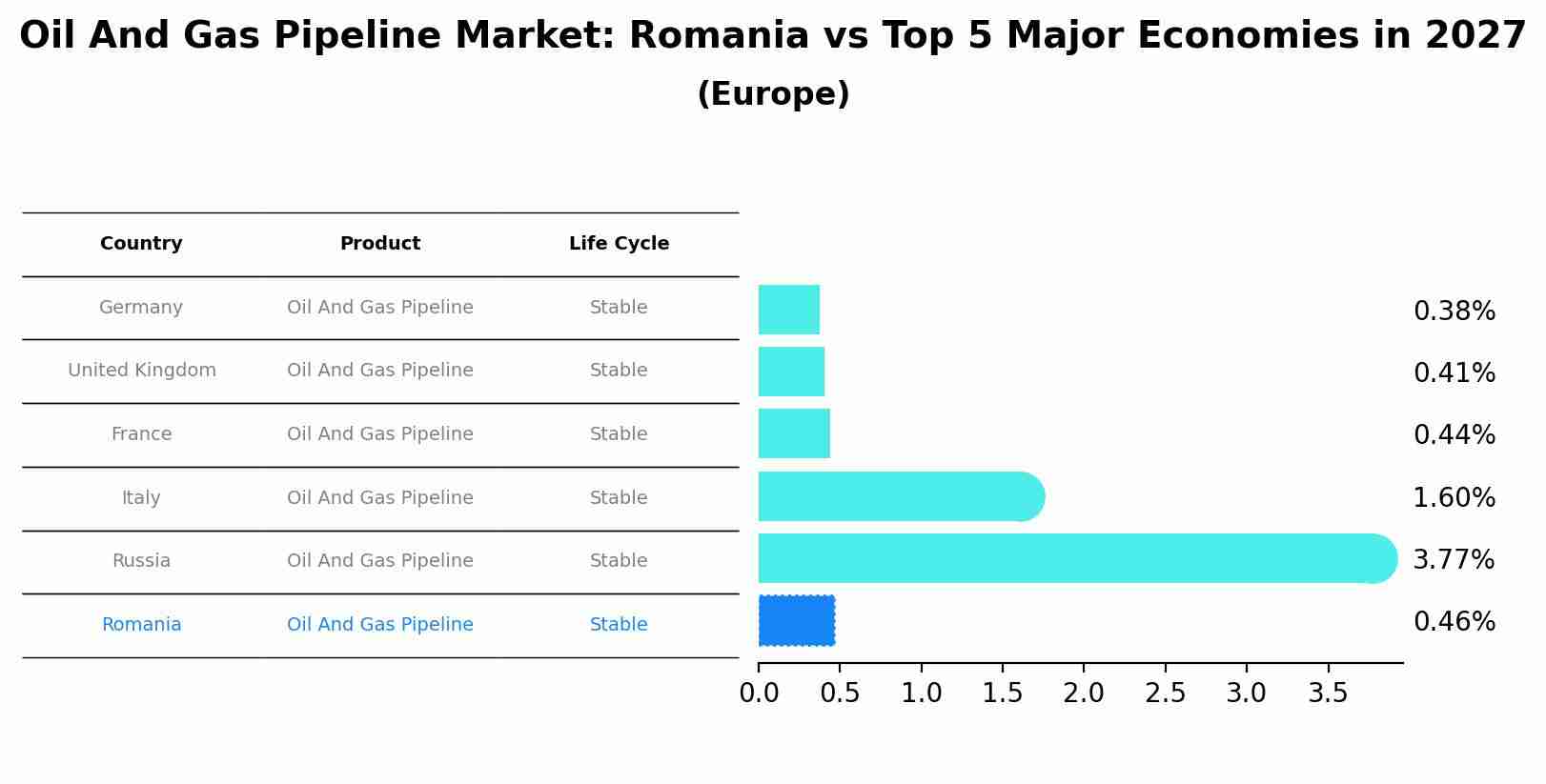Romania Oil And Gas Pipeline Market Outlook | Share, Trends, Growth, Revenue, Size, Forecast, Industry, COVID-19 IMPACT, Analysis, Companies & Value
| Product Code: ETC377298 | Publication Date: Aug 2022 | Updated Date: Jul 2025 | Product Type: Market Research Report | |
| Publisher: 6Wresearch | Author: Dhaval Chaurasia | No. of Pages: 75 | No. of Figures: 35 | No. of Tables: 20 |
Romania Oil And Gas Pipeline Market Size Growth Rate
The Romania Oil And Gas Pipeline Market is projected to witness mixed growth rate patterns during 2025 to 2029. Growth accelerates to 0.49% in 2028, following an initial rate of 0.36%, before easing to 0.48% at the end of the period.

Oil And Gas Pipeline Market: Romania vs Top 5 Major Economies in 2027 (Europe)
By 2027, Romania's Oil And Gas Pipeline market is forecasted to achieve a stable growth rate of 0.46%, with Germany leading the Europe region, followed by United Kingdom, France, Italy and Russia.

Romania Oil And Gas Pipeline Market Synopsis
The Romania Oil and Gas Pipeline Market is characterized by a network of pipelines that transport crude oil and natural gas across the country. The market is primarily driven by the demand for energy resources, industrial development, and the country`s strategic geographical location as a transit hub for oil and gas supplies in the region. Key players in the market include Transgaz, the state-owned gas pipeline operator, and other private companies involved in the construction and operation of pipelines. The market is influenced by government regulations, environmental concerns, and investment in infrastructure projects to enhance the efficiency and safety of the pipeline network. With ongoing developments in the energy sector and efforts to diversify energy sources, the Romania Oil and Gas Pipeline Market is expected to witness steady growth and innovation in the coming years.
Romania Oil And Gas Pipeline Market Trends
The Romania Oil and Gas Pipeline Market is experiencing several key trends. One significant trend is the focus on enhancing pipeline infrastructure to support the country`s energy security and diversification goals. Investment in pipeline modernization, expansion, and maintenance projects is a priority to ensure reliable transportation of oil and gas resources. Additionally, there is a growing emphasis on environmental sustainability, with a shift towards more efficient and eco-friendly pipeline technologies. Another trend is the increasing integration of digital technologies such as IoT and AI to improve pipeline monitoring and maintenance practices, enhancing operational efficiency and safety. Overall, the Romania Oil and Gas Pipeline Market is evolving towards a more resilient, efficient, and environmentally conscious infrastructure system to meet the country`s energy needs.
Romania Oil And Gas Pipeline Market Challenges
In the Romania Oil and Gas Pipeline Market, several challenges are faced, including regulatory uncertainties, geopolitical risks, and changing market dynamics. The regulatory environment in Romania can be complex and subject to frequent changes, leading to uncertainty for pipeline operators. Geopolitical risks, such as tensions with neighboring countries or changes in government policies, can impact the stability of the market. Additionally, the evolving market dynamics, such as fluctuating oil and gas prices, technological advancements, and increasing competition, pose challenges for pipeline companies to stay competitive and adapt to changing conditions. Overall, navigating these challenges requires a strategic approach, strong risk management practices, and a focus on innovation and efficiency in the pipeline sector.
Romania Oil And Gas Pipeline Market Investment Opportunities
In the Romania Oil and Gas Pipeline Market, there are various investment opportunities across different segments of the industry. One promising opportunity lies in the expansion and modernization of the existing pipeline infrastructure to enhance transportation capacity and efficiency. Investing in the construction of new pipelines to connect key production areas with demand centers can also be lucrative. Additionally, there is potential for investment in pipeline maintenance and repair services to ensure the safe and reliable operation of the infrastructure. With Romania`s strategic location and growing energy demand, investing in the oil and gas pipeline market presents opportunities for long-term growth and returns for investors looking to capitalize on the country`s energy sector development.
Jordan Agar Market Government Policies
The Romania Oil and Gas Pipeline Market is regulated by the Romanian government through various policies and regulations. The government has implemented laws to promote the development and maintenance of the pipeline infrastructure to ensure the efficient transportation of oil and gas within the country. This includes regulations on pipeline construction, operation, safety standards, and environmental protection measures. Additionally, the government has policies in place to encourage investment in the oil and gas sector, such as providing incentives for exploration and production activities. Overall, the government`s policies aim to support the growth and sustainability of the oil and gas pipeline market in Romania while ensuring compliance with industry standards and environmental regulations.
Romania Oil And Gas Pipeline Market Future Outlook
The future outlook for the Romania Oil and Gas Pipeline Market appears promising with steady growth projected in the coming years. The market is expected to benefit from ongoing investments in infrastructure development, increasing demand for energy resources, and government initiatives aimed at expanding the country`s energy sector. Additionally, Romania`s strategic location as a key transit country for oil and gas supplies in the region further enhances the market`s potential for growth. However, challenges such as regulatory changes, environmental concerns, and competition from alternative energy sources may impact the market dynamics. Overall, the Romania Oil and Gas Pipeline Market is anticipated to witness sustained growth driven by infrastructure development, energy demand, and strategic positioning in the regional energy landscape.
Key Highlights of the Report:
- Romania Oil And Gas Pipeline Market Outlook
- Market Size of Romania Oil And Gas Pipeline Market, 2021
- Forecast of Romania Oil And Gas Pipeline Market, 2031
- Historical Data and Forecast of Romania Oil And Gas Pipeline Revenues & Volume for the Period 2018 - 2031
- Romania Oil And Gas Pipeline Market Trend Evolution
- Romania Oil And Gas Pipeline Market Drivers and Challenges
- Romania Oil And Gas Pipeline Price Trends
- Romania Oil And Gas Pipeline Porter's Five Forces
- Romania Oil And Gas Pipeline Industry Life Cycle
- Historical Data and Forecast of Romania Oil And Gas Pipeline Market Revenues & Volume By Location of Deployment for the Period 2018 - 2031
- Historical Data and Forecast of Romania Oil And Gas Pipeline Market Revenues & Volume By Onshore for the Period 2018 - 2031
- Historical Data and Forecast of Romania Oil And Gas Pipeline Market Revenues & Volume By Offshore for the Period 2018 - 2031
- Historical Data and Forecast of Romania Oil And Gas Pipeline Market Revenues & Volume By Type for the Period 2018 - 2031
- Historical Data and Forecast of Romania Oil And Gas Pipeline Market Revenues & Volume By Crude Oil Pipeline for the Period 2018 - 2031
- Historical Data and Forecast of Romania Oil And Gas Pipeline Market Revenues & Volume By Gas Pipeline for the Period 2018 - 2031
- Romania Oil And Gas Pipeline Import Export Trade Statistics
- Market Opportunity Assessment By Location of Deployment
- Market Opportunity Assessment By Type
- Romania Oil And Gas Pipeline Top Companies Market Share
- Romania Oil And Gas Pipeline Competitive Benchmarking By Technical and Operational Parameters
- Romania Oil And Gas Pipeline Company Profiles
- Romania Oil And Gas Pipeline Key Strategic Recommendations
Frequently Asked Questions About the Market Study (FAQs):
- Single User License$ 1,995
- Department License$ 2,400
- Site License$ 3,120
- Global License$ 3,795
Search
Related Reports
- ASEAN Bearings Market (2025-2031) | Strategy, Consumer Insights, Analysis, Investment Trends, Opportunities, Growth, Size, Share, Industry, Revenue, Segments, Value, Segmentation, Supply, Forecast, Restraints, Outlook, Competition, Drivers, Trends, Demand, Pricing Analysis, Competitive, Strategic Insights, Companies, Challenges
- Europe Flooring Market (2025-2031) | Outlook, Share, Industry, Trends, Forecast, Companies, Revenue, Size, Analysis, Growth & Value
- Saudi Arabia Manlift Market (2025-2031) | Outlook, Size, Growth, Trends, Companies, Industry, Revenue, Value, Share, Forecast & Analysis
- Uganda Excavator, Crane, and Wheel Loaders Market (2025-2031) | Strategy, Consumer Insights, Analysis, Investment Trends, Opportunities, Growth, Size, Share, Industry, Revenue, Segments, Value, Segmentation, Supply, Forecast, Restraints, Outlook, Competition, Drivers, Trends, Demand, Pricing Analysis, Competitive, Strategic Insights, Companies, Challenges
- Rwanda Excavator, Crane, and Wheel Loaders Market (2025-2031) | Strategy, Consumer Insights, Analysis, Investment Trends, Opportunities, Growth, Size, Share, Industry, Revenue, Segments, Value, Segmentation, Supply, Forecast, Restraints, Outlook, Competition, Drivers, Trends, Demand, Pricing Analysis, Competitive, Strategic Insights, Companies, Challenges
- Kenya Excavator, Crane, and Wheel Loaders Market (2025-2031) | Strategy, Consumer Insights, Analysis, Investment Trends, Opportunities, Growth, Size, Share, Industry, Revenue, Segments, Value, Segmentation, Supply, Forecast, Restraints, Outlook, Competition, Drivers, Trends, Demand, Pricing Analysis, Competitive, Strategic Insights, Companies, Challenges
- Angola Excavator, Crane, and Wheel Loaders Market (2025-2031) | Strategy, Consumer Insights, Analysis, Investment Trends, Opportunities, Growth, Size, Share, Industry, Revenue, Segments, Value, Segmentation, Supply, Forecast, Restraints, Outlook, Competition, Drivers, Trends, Demand, Pricing Analysis, Competitive, Strategic Insights, Companies, Challenges
- Israel Intelligent Transport System Market (2025-2031) | Strategy, Consumer Insights, Analysis, Investment Trends, Opportunities, Growth, Size, Share, Industry, Revenue, Segments, Value, Segmentation, Supply, Forecast, Restraints, Outlook, Competition, Drivers, Trends, Demand, Pricing Analysis, Competitive, Strategic Insights, Companies, Challenges
- Uganda Precast and Aggregate Market (2025-2031) | Strategy, Consumer Insights, Analysis, Investment Trends, Opportunities, Growth, Size, Share, Industry, Revenue, Segments, Value, Segmentation, Supply, Forecast, Restraints, Outlook, Competition, Drivers, Trends, Demand, Pricing Analysis, Competitive, Strategic Insights, Companies, Challenges
- Australia IT Asset Disposal Market (2025-2031) | Strategy, Consumer Insights, Analysis, Investment Trends, Opportunities, Growth, Size, Share, Industry, Revenue, Segments, Value, Segmentation, Supply, Forecast, Restraints, Outlook, Competition, Drivers, Trends, Demand, Pricing Analysis, Competitive, Strategic Insights, Companies, Challenges
Industry Events and Analyst Meet
Our Clients
Whitepaper
- Middle East & Africa Commercial Security Market Click here to view more.
- Middle East & Africa Fire Safety Systems & Equipment Market Click here to view more.
- GCC Drone Market Click here to view more.
- Middle East Lighting Fixture Market Click here to view more.
- GCC Physical & Perimeter Security Market Click here to view more.
6WResearch In News
- Doha a strategic location for EV manufacturing hub: IPA Qatar
- Demand for luxury TVs surging in the GCC, says Samsung
- Empowering Growth: The Thriving Journey of Bangladesh’s Cable Industry
- Demand for luxury TVs surging in the GCC, says Samsung
- Video call with a traditional healer? Once unthinkable, it’s now common in South Africa
- Intelligent Buildings To Smooth GCC’s Path To Net Zero













